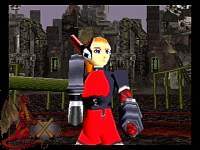|
|

|
BATTLE SYSTEM
|

|
INTERACTION
|

|
ORIGINALITY
|

|
STORY
|

|
MUSIC & SOUND
|

|
VISUALS
|

|
CHALLENGE
|
Firm
|
COMPLETION TIME
|
20-28 hours
|
|
OVERALL
4.0/5
|
Rating definitions
|
|
|
Adherents of the Sega Saturn always had to look towards Japan for games, thanks to the frequency of promising titles’ denial for translation. 1998 was in many ways a prime time to be a Japanese Saturn owner, as a plethora of worthwhile RPGs and other titles were released for the system with a mere single-digit count reaching across the Pacific. One title released in 1998 for the Saturn that, naturally, did not receive an English translation is Wachenroder. While not the best tactical title for the Saturn, it certainly merits a look by anyone with a system and inkling to look up a very atmospheric game. It is in Japanese (with a sprinkling of German), but there is also a translation on GameFAQs that will prove very handy to one seeking an understanding of the story.
That story begins with a prologue in which Lucian is trying to earn enough money, somehow, to save his sister from death due to the incessant pollutants of steam-powered machinery in the atmosphere. He fails in this, and becomes a withdrawn loner seeking one to whom he can assign responsibility for the environmental degradation that cost his sister’s life. Four years later a young woman named Carroll convinces a very drunk Lucian to aid her in a battle against Guardians, enforcers of the Steam Lords who control the land. Lucian doesn’t remember the fight come morning thanks to his very sodden state, but he agrees to continue aiding Carroll because she may be able to find Duran, builder of the polluting factory closest to his home that he blames for the death of his sister. From here many entanglements with the authorities will result…
 Special attacks bring Virtua Fighter to mind. Hopefully that isn’t a problem.
Special attacks bring Virtua Fighter to mind. Hopefully that isn’t a problem.
|
|
These entanglements, naturally, result in the airing of grievances via battle. Battle looks somewhat like it does in many tactical titles, with movement and attacking appearing to be the same. What separates Wachenroder’s battles from the rest of tactical titles resides in both the AP awarded to every combatant and the steam power source of weaponry. Every combatant on the field, friend and foe, possesses 99 AP per turn. These 99 AP can be used for anything, and are used for everything. Movement requires a set amount of AP per turn. Attacking requires a set amount per turn (and these amounts very per character, with alteration via accessories being possible). Flipping a switch (necessary in many battles to shift things around) also requires AP. A character can continue performing actions until bereft of sufficient AP to do anything.
The steam-powered aspect of weaponry results in the tendency of them to overheat. Every time an attack is made, the character can choose the strength – from 1 to 5 on a gauge. Using an attack at 5 power will nearly overheat a weapon, however, and once a weapon is overheated a minimum of one turn must elapse during which that character cannot attack at all. There are also special attacks. These require 50 AP (or 70 for an even more powerful version late in the game) for every character to use, and will heat up weapons greatly – but do damage sufficient to take out most enemies in one shot. Heat can be somewhat compensated for by devoting all remaining AP to cooling for a turn. Weather also plays a role, as the ambient temperature will greatly influence how quickly weapons overheat.
There are three types of weapons in Wachenroder, with the sword type being most common. ‘Sword’ here denotes weapons which are melee-only. Gun type and bow type are the distance attackers, with guns needing a clear line-of-sight to the target but being useful for both melee and greater range while bows do not require line-of-sight but are useless at melee range. Height plays a very important role in Wachenroder also: if the attacker is at a lower elevation considerably less damage can be done and much more damage will be returned. Player-controlled female characters have the ability to heal their compatriots for 15 AP with each use. This might seem excessive, save for there being more men than women in the game and the lack of any healing items or magic. Without the women being able to heal, there would be no method.
 No – nooooooo! Blue screens of death!
No – nooooooo! Blue screens of death!
|
|
Experience is awarded for killing enemies, and though the experience is not numbered more is granted for killing a higher-level opponent. Money is awarded at the end of each battle based upon how quickly it was cleared. As there is a finite amount of equipment to buy and a finite number of opportunities to buy it, lack of funds is not an enormous issue when equipment is also awarded post-battle.
There are a few issues here. First is the isometric perspective; though the camera can be rotated to face in four directions and tilted somewhat up and down, the isometric perspective still makes it difficult to see at times. Particularly if the player is moving a character from a space which is clear to underneath a metal strut – this happens in several battles and is very vexing. Another issue deals with the multiple levels of height in a number of battles. Being too hasty in moving the cursor around the battlefield usually results in the cursor suddenly ending up below or above where the player intended it to be. The Z button will switch the cursor around between levels of height, but if the player managed to maneuver the cursor over a stretch of empty air it must be adjusted further because the cursor will not stay over air. There is also the need of some battles to get every surviving character into a certain space – Lucian alone won’t do.
Visuals are not necessarily bad-looking; they just seem to work at cross-purposes. The cute sprites on the battlefield do not match the art style of the game as revealed in still pictures and in the manual, which is significantly more realistic and gritty than in many Japanese-developed titles. Leaving that somewhat jarring bit aside, the 3D battle moments that are shown when special attacks are used look worse than those in Shining Force III Scenario 1, which is a shame. The sun does not rise much in the world of Wachenroder either, so expect a lot of darkness.
As to the audio side, there is a fair amount of voice acting during story segments. It’s pretty well-done save for the unfortunate decision to keep the music at the same volume during voice acting. The music itself is generally quite good, with several rockin’ battle themes and a nice variety of other styles. Some of the tracks are a bit short, but no cause for complaint with the musical composition can be found and the Saturn’s sound chip allows for good quality.
Wachenroder is one of the most linear titles I have ever played, with no opportunities to move around off the beaten path at all. In fact there are no opportunities to move around outside of battle. Thus replay is probably nonexistent for most players. Depending upon how much translation effort the player wants to put in, and how long the battles take, 20 hours seems a reasonable minimum for completion with the upper end adding 6-10 more hours.
Challenge isn’t terribly high, provided the player avoids a dumb mistake. Letting Lucian fall is always a condition for defeat, and enemies will go after him. Lucian is a long way from weak but in Wachenroder even a peon could conceivably take him down if granted access to his back from above with more than one attack possible that turn. Bosses are not terribly strong in stamina, but their having special attacks that WILL kill the character they are turned against means great precautions must be taken. Bosses also will inconveniently refuse to move until a character is close enough to have sufficient AP for executing a special attack.
The translation for this game on GameFAQs is most helpful in persuading potential players to give it a try. Even without understanding the story’s nuances, however, Wachenroder deserves a try from tactical aficionados searching out a worthwhile title. The game is not terribly cheap but neither is it expensive, making it an easier acquisition than some Saturn titles.
Review Archives
|









